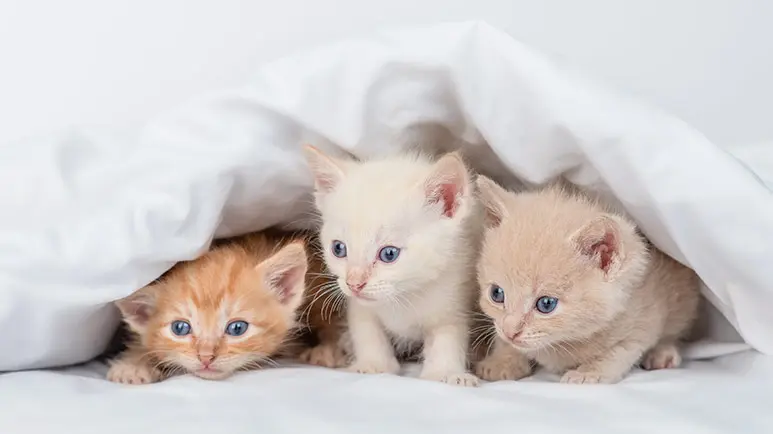Your Tiny Fluff Ball’s First 5 Weeks — 5 Big Milestones You Don’t Want to Miss
What a difference a few short weeks can make! By the grand old age of 5 weeks, your fluff ball has been through so many changes it can make your head spin. Do you know what they are? You'll want to, so you understand your new tiny family member and can talk intelligently with your vet.

STORY AT-A-GLANCE
- New kitten parents are often very curious about what to expect as their pet grows from a tiny ball of fluff into a regal adult cat
- There are five major milestones in the life of a kitten that occur from birth through the fifth week of life
- These are general age-related milestones. It’s important to remember that each kitty develops at his or her own pace based on several factors, including breed
Editor's Note: This article is a reprint. It was originally published January 24, 2017.
New kitten parents often have lots of questions about how their tiny feline friend will grow and develop and learn. Every kitten has his or her own personality and temperament, but all kittens achieve similar milestones during their first year.
Weeks 1 through 6 are the period during which kittens grow and develop very rapidly. Since they're all a little different, some may progress a bit more slowly, while others develop more quickly than average.
There's no need for concern unless the rate of your kitten's development is significantly different from the norm.
In veterinary terms, cats are considered kittens from birth to 6 months, juniors from 7 months to 2 years, prime from 3 to 6 years, mature from 7 to 10 years, senior from 11 to 14 years and geriatric at 15 years and older.
5 Milestones in Every Kitten's Life
- Stage 1: Newborn — Kittens weigh only a few ounces at birth, but they grow very fast, with most doubling their weight in the first week of life. During this time, the mother cat knows she must keep her babies warm, nourish them and stimulate (lick) their bodies to encourage digestion and elimination.
The first milk a mother cat produces is colostrum, which contains the antibodies that transfer maternal immunity to help protect her kittens from opportunistic diseases during their first weeks of life.
Newborn babes can't move around much, and the only noise they make is a faint mew. What remains of the umbilical cord typically drops off on day two or three.
Newborn kittens can neither see nor hear, since they're born with their eyes sealed shut and their ears folded. They are also born toothless. At some point between days five and 14, kitty's little ears will start to unfold and her eyes (always blue at first) begin to open. - Stage 2: 2-week old kitten — At 2 weeks, kittens begin to develop a sense of smell and their eyes open completely, though their vision is still blurry and sensitive to bright lights.
At this stage, kittens become aware of their littermates and begin to compete for mom's nipples at mealtime. - Stage 3: 3-week old kitten — During his third week of life, kitty's sense of smell is fully established and his ears become erect, though his hearing is still developing.
He may start to get his little purr on, and baby teeth will begin to push up through his gums. His adult teeth will begin to replace them in a few months. Brief, gentle handling is started at this point.1
At this stage, mama cat doesn't have to be quite so attentive to her litter. She no longer needs to stimulate her kittens to help them digest food or eliminate, but she does still have most of the grooming duties. - Stage 4: 4-week old kitten — At 4 weeks, kittens begin to interact with their littermates and show interest in their surroundings. They may attempt a few wobbly steps. By the end of the week, they're typically exploring and playing when they're not napping or nursing.
- Stage 5: 5-week old kitten — By 5 weeks of age, kitty's vision is fully developed and her eye color may begin to change. She's growing more adventurous. Walking is less challenging and pouncing on littermates becomes great fun.
Your tiny, vulnerable kitten is now a furry little dynamo, in constant motion when she's awake.
This is exactly the right time to begin actively socializing her and getting her used to human handling. You can also introduce her to solid food this week, but she'll still need to nurse and isn't quite ready to be weaned.
This is also a good time to introduce your kitten to her litterbox. I recommend starting with a shallow box lid that she can easily step into and out of, with just a few inches of litter.
Over the next several weeks your kitten will continue to grow and develop, but at a much slower pace. By about week 8, all his very sharp baby teeth will be in and he'll be fully weaned within the next couple of weeks. By the end of week 9, kitty will weigh about 3 pounds and his eyes will be their permanent adult color.
It's important to keep in mind that these are general aging milestones. Each cat develops on his or her own timeline based on breed and other factors.











